Snow geese and swans, two distinct avian species, captivate with their diverse behaviors and distinct physical attributes. These birds, often associated with aquatic habitats, display remarkable differences that extend beyond their appearances.
From their migratory behaviors and vocalizations to their nesting habits and interactions with humans, snow geese and swans carve distinct niches within their ecosystems.
Understanding these distinctions enriches our appreciation of the avian world’s intricate tapestry, where each species weaves its unique thread into the ecological fabric.
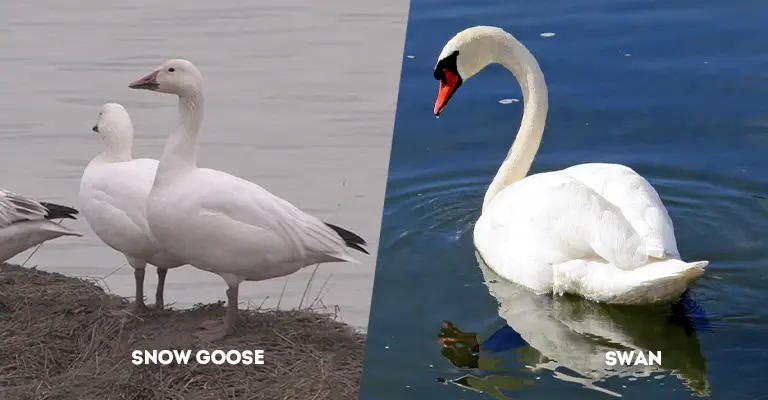
Key Differences Between Snow Goose and Swan
Wing Color
- Snow Goose: The wing color of the snow goose is a key distinguishing feature. Snow geese have black primary feathers on their wings. This coloration is particularly visible when their wings are spread during flight.
The stark contrast between the white body feathers and the black wing feathers is a significant aspect of their appearance. - Swan: Swans, on the other hand, possess wings entirely white in color. This consistent whiteness of their wings is a hallmark feature. The swan’s elegant flight, combined with its all-white wings, contributes to its graceful presence both on water and in the sky.
Neck Length
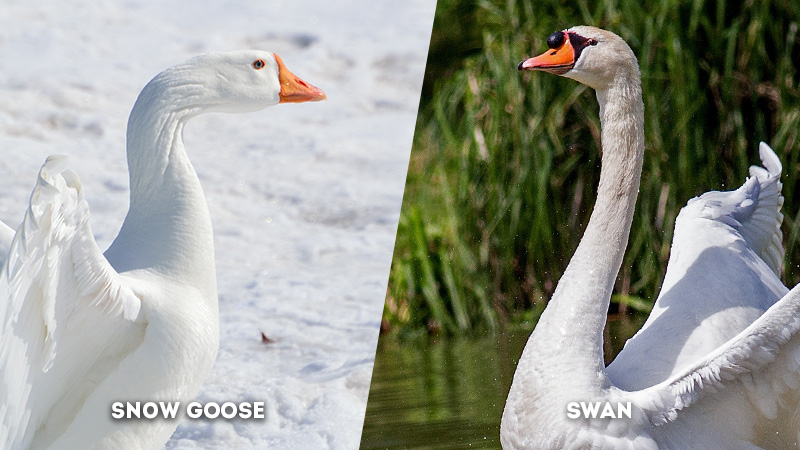
- Snow Goose: One of the striking differences between snow geese and swans is their neck length. Snow geese have relatively short necks, which might not be as prominent in their overall appearance. This feature aligns with their feeding habits and general behaviors.
- Swan: Swans are renowned for their long and slender necks, which are immediately recognizable.
Their graceful curves and elongated necks contribute to their regal and majestic demeanor. Swans often use their extended necks to reach underwater vegetation while feeding.
Bill Color
- Snow Goose: The bill of a snow goose is characterized by its black color with a distinctive “grinning patch.”
This patch is a noticeable feature that sets the snow goose apart from other bird species. The black bill contrasts with the white plumage of the body, making it easily recognizable. - Swan: Swan species exhibit varying bill colors. Depending on the species, swans can have bills that are orange, black, or other shades. The color of the bill, combined with its size and shape, contributes to the swan’s overall appearance.
Body Size
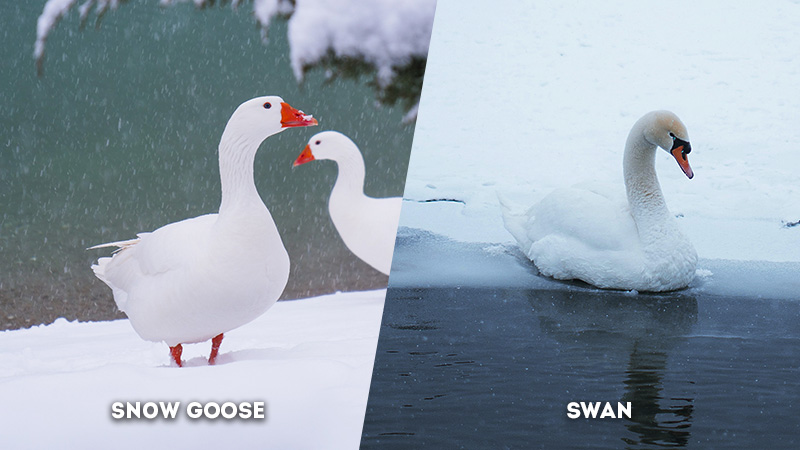
- Snow Goose: Snow geese are categorized as medium-sized birds. Their size falls between smaller waterfowl and larger birds like swans. This size is well-suited to their migratory behaviors and foraging habits.
- Swan: Swans are notably larger than snow geese. Their size contributes to their impressive presence, especially when seen gliding across the water. The combination of their size, long necks, and elegant movements defines their characteristic appearance.
Habitat
- Snow Goose: Snow geese exhibit a wide range of habitats, often favoring wetlands and open spaces. They are known to frequent a variety of environments, including coastal areas, tundra, and agricultural fields.
Their habitat preferences correspond to their feeding habits and migration patterns. - Swan: Swans typically inhabit aquatic environments, such as lakes, ponds, rivers, and marshes. Their aquatic nature is supported by their physical adaptations, including their long necks and webbed feet, which make them adept swimmers.
These habitats provide them with ample access to their primary food sources of aquatic vegetation.
Migratory Behavior
- Snow Goose: Snow geese are highly migratory birds known for their extensive journeys. They undertake long-distance migrations, traveling thousands of miles between their breeding grounds in the Arctic and their wintering areas in the southern United States and Mexico.
This migratory behavior is driven by the need to find suitable breeding and feeding grounds throughout the year. - Swan: Swan species exhibit a range of migratory behaviors. While some swan populations are migratory and travel long distances, others are more sedentary and remain in their breeding habitats year-round.
The migratory patterns of swans depend on factors such as species, geographic location, and environmental conditions.
Vocalizations
- Snow Goose: Snow geese are known for their distinct “honking” calls that can be heard during migration or when they gather in flocks.
These vocalizations serve various purposes, including maintaining group cohesion during flight and communicating important information among individuals. - Swan: Swans are recognized for their resonant and melodic vocalizations. Their calls can include trumpeting and whistling sounds that carry across water bodies.
These vocalizations play a role in territorial defense, communication between mates and family members, and expressing emotions.
Flight Pattern
- Snow Goose: Snow geese are known for their fast and direct flight patterns during migration. They often fly in V-shaped or diagonal formations, which provide aerodynamic advantages and reduce air resistance for the birds following the leader. This pattern also helps with navigation and conserving energy during long flights.
- Swan: Swans exhibit graceful and elegant flight patterns, characterized by slow and deliberate wingbeats. Their flight is often characterized by the sweeping arc of their wings and the elongated neck extended straight ahead.
While not as rapid as snow geese, swans’ flight patterns convey a sense of beauty and serenity.
Feeding Behavior
- Snow Goose: Snow geese primarily graze on grasses, grains, and other vegetation. Their short necks are well-suited for feeding on plants found in open areas and wetlands. Their feeding behavior can significantly impact the vegetation in their habitats, particularly during large-scale migrations.
- Swan: Swans are herbivores with a diet primarily consisting of aquatic vegetation such as submerged plants, algae, and waterweeds. Their long necks allow them to reach underwater plants, and they may also forage on land for grasses and grains.
Swans’ feeding habits contribute to the health of aquatic ecosystems by controlling plant growth and nutrient cycling.
Social Behavior
- Snow Goose: Snow geese are often found in large flocks, especially during migration and in wintering areas. These flocks can consist of thousands of individuals, and the birds exhibit social behaviors that promote group cohesion and safety. They also tend to travel in family units, contributing to the protection of young goslings.
- Swan: Swans exhibit variable social behaviors. While some species are more solitary, others form pairs or small family groups. Swans are known for their strong pair bonds, often forming lifelong partnerships with their mates.
They engage in behaviors like synchronized swimming and mutual preening, which strengthen their social bonds.
Nesting Habits
- Snow Goose: Snow geese often build their nests on the ground or in shallow depressions. These nests are relatively simple, constructed with a combination of plant materials and down feathers.
Their ground-level nesting provides camouflage and protection against predators, helping to ensure the safety of their eggs and young. - Swan: Swans are known for building larger and more elaborate nests. They often create nests made of reeds, aquatic plants, and other vegetation.
These nests are constructed near water bodies, floating on the surface or anchored in marshes. Swans’ nesting behaviors reflect their affinity for aquatic environments and their reliance on water for food and protection.
Nesting Sites
- Snow Goose: Snow geese typically choose nesting sites in Arctic tundra regions during their breeding season. These areas provide access to abundant food resources and relatively safe conditions for raising their young. The tundra’s open landscapes allow snow geese to establish nests in areas with good visibility.
- Swan: Swans prefer nesting sites near water bodies such as lakes, ponds, and rivers. The proximity to water ensures easy access to their primary food sources, and it also provides protection against land-based predators.
The water also aids in maintaining the moisture levels necessary for their eggs and the development of their young.
Egg Color
- Snow Goose: The eggs of snow geese are typically olive-green to brown in color. This coloring serves as effective camouflage in their tundra nesting sites, blending with the surrounding vegetation and helping to protect the eggs from potential predators.
- Swan: Swan eggs have a consistent white color. This coloration is advantageous in the context of their nesting sites, as the white eggs stand out against the natural hues of the nest materials, making it easier for parents to spot any potential disturbances or threats.
Clutch Size
- Snow Goose: Snow geese usually lay clutches of about 3 to 5 eggs. The relatively small clutch size is reflective of the harsh conditions in their Arctic breeding grounds, where resources may be limited. Smaller clutches may allow parents to invest more energy into each individual chick’s survival.
- Swan: Swan clutch sizes can vary depending on the species. For example, mute swans often lay clutches of 4 to 7 eggs, while other species may lay fewer eggs. The larger clutch sizes of swans are indicative of their ability to find and utilize resources in more favorable environments.
Incubation Period
- Snow Goose: The incubation period for snow goose eggs lasts about 23 to 25 days. During this time, the parents take turns incubating the eggs, sharing the responsibilities of maintaining the appropriate temperature and protecting the eggs from potential threats.
- Swan: Swan eggs have a longer incubation period, typically lasting around 30 to 40 days. The extended incubation period may reflect the larger size of swan eggs and the additional time required for the embryos to develop.
Lifespan
- Snow Goose: Snow geese generally have a lifespan of around 5 to 15 years in the wild. Their relatively shorter lifespan can be attributed to the challenges they face during their long migrations, exposure to predators, and other environmental factors that impact their survival.
- Swan: Swans, in contrast, have the potential for longer lifespans. Some species of swans can live for over 20 years, with survival influenced by factors such as habitat quality, predation rates, and the availability of resources.
Family Units
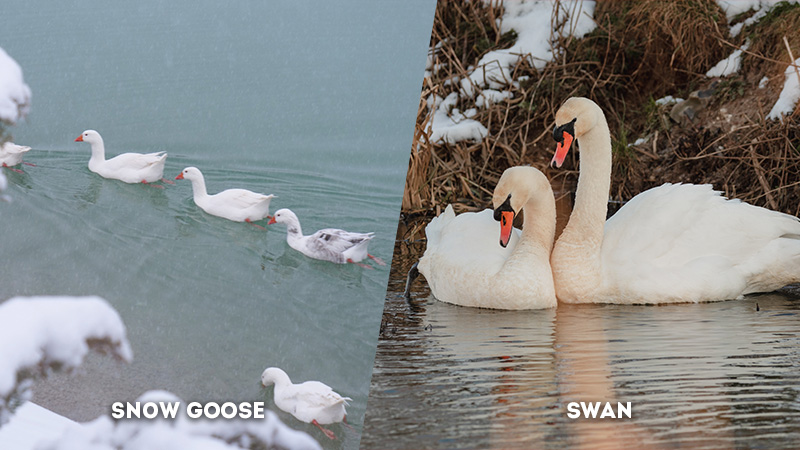
- Snow Goose: Snow geese often travel in family units, especially during migration. These family groups consist of parents and their offspring, contributing to the protection and guidance of the young goslings during their journeys.
- Swan: Swans also engage in family-oriented behavior. They form strong pair bonds, with some species forming lifelong partnerships.
These pairs often work together to raise their young, and swans are known for their synchronized swimming and preening behaviors, which strengthen their social bonds.
Behavior Towards Humans
- Snow Goose: Snow geese can exhibit varying behaviors towards humans. Some populations have become accustomed to human presence due to frequent interactions in urban and agricultural settings, making them less shy and more approachable.
- Swan: Swans’ behavior towards humans can vary widely based on their experiences and the presence of human activities in their habitats.
While some swans may be more tolerant of human presence, others can display wariness and protective behaviors, especially during nesting periods.
Flight Formation
- Snow Goose: During migration, snow geese often fly in V-shaped or diagonal formations. This flight pattern optimizes aerodynamics and energy efficiency, as birds follow the lead of the one in front, reducing wind resistance and aiding navigation.
- Swan: Swans’ flight patterns are characterized by their graceful and deliberate wingbeats. Their flight is more serene compared to the rapid and direct flight of snow geese. This pattern is reflective of their larger body size and their preference for aquatic habitats.
Feet Color
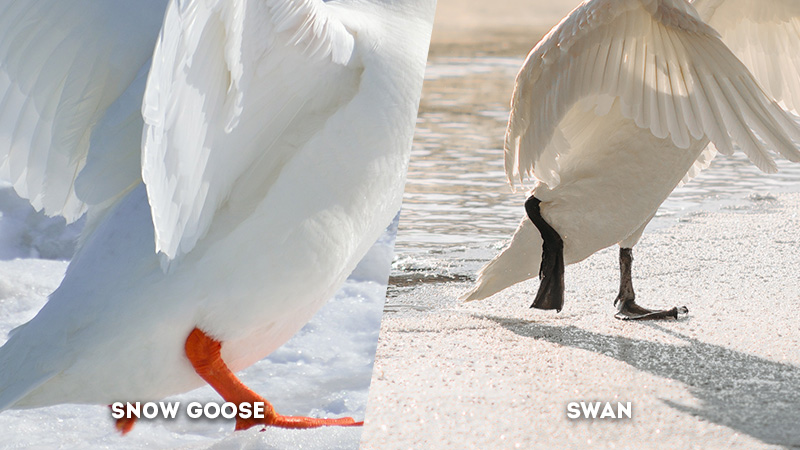
- Snow Goose: Snow geese typically have pink or orange feet. The color of their feet contrasts with their plumage and can be used as an additional identifying feature when observing these birds.
- Swan: Swans’ feet color varies depending on the species. Some species have black or gray feet, which blend with their overall coloration. The color of swans’ feet complements their elegant appearance, both in water and on land.
Geographic Range
- Snow Goose: Snow geese have a widespread geographic range, with their breeding grounds located in the Arctic regions of North America.
During migration, they travel southward to wintering areas in the southern United States and Mexico. This extensive migratory range allows them to exploit diverse habitats throughout the year. - Swan: Swans exhibit a global distribution, with different species found on nearly every continent. They inhabit a range of aquatic habitats, from temperate regions to the Arctic. The various species of swans showcase their adaptability to different climates and environments.
Conservation Status
- Snow Goose: The conservation status of snow geese varies based on different populations. While some populations are stable, others face threats such as habitat loss and hunting. However, due to effective management and conservation efforts, certain populations have rebounded over the years.
- Swan: Swan species have varying conservation statuses as well. Some swan species are considered stable, while others are classified as threatened or vulnerable.
Factors such as habitat degradation, pollution, and disturbance in their habitats contribute to their conservation challenges.
Young Appearance
- Snow Goose: Snow geese chicks, also known as goslings, hatch from eggs with downy feathers that are usually grayish in color. These fluffy down feathers provide insulation and protection for the vulnerable young birds.
Goslings are precocial, meaning they are relatively independent and mobile shortly after hatching. - Swan: Swan cygnets, or young swans, hatch with gray down feathers that eventually give way to their characteristic white plumage as they mature. Cygnets are also precocial, and they learn essential behaviors from their parents, such as feeding and swimming.
Wintering Areas
- Snow Goose: During the winter months, snow geese migrate to warmer regions. These wintering areas include parts of the southern United States, Mexico, and Central America. These migratory journeys ensure access to food and milder climates during the harsh Arctic winters.
- Swan: Swans also exhibit migratory behavior during winter, with some populations moving to more temperate regions to escape freezing conditions. Others, however, remain in their breeding habitats year-round if the conditions are favorable.
Beak Shape
- Snow Goose: Snow geese have relatively short and stubby bills. Their bills are adapted for grazing on grasses and grains, which constitute a significant portion of their diet. This beak shape allows them to efficiently forage for food in open fields and wetlands.
- Swan: Swans possess long and gracefully curved bills that are adapted for their aquatic lifestyles. Their bills are used for filtering and grasping aquatic vegetation and food from water bodies.
Behavior in Water
- Snow Goose: Snow geese are less elegant in water compared to swans. They are more agile on land, where their shorter necks and sturdier bodies are advantageous. While they can swim and feed in water, their primary feeding activities occur on land.
- Swan: Swans are renowned for their grace and beauty in water. Their elongated necks and webbed feet make them adept swimmers, and they glide gracefully across water bodies. Their behavior in water is an integral part of their identity and ecological role as aquatic birds.
Snow Goose Vs Swan: Comparison Table
| Feature | Snow Goose | Swan |
|---|---|---|
| Wing Color | Black primary feathers | All-white wings |
| Neck Length | Short | Long and slender |
| Bill Color | Black with a “grinning patch” | Varies by species; can be orange, black, etc. |
| Body Size | Medium-sized | Large and majestic |
| Habitat | Variety of habitats, often wetlands | Aquatic habitats, like lakes and rivers |
| Migratory Behavior | Highly migratory | Variable; some are migratory, others not |
| Vocalizations | “Honking” calls | Trumpeting and whistling |
| Flight Pattern | Fast and direct | Graceful and elegant |
| Feeding Behavior | Grazes on grasses and grains | Herbivorous, feeding on aquatic vegetation |
| Social Behavior | Often found in large flocks | Can be solitary or in small groups |
| Nesting Habits | Nests on the ground or in shallow depressions | Build large nests on the ground or in reeds |
| Nesting Sites | Arctic tundra during breeding | Near water bodies or wetlands |
| Egg Color | Olive-green to brown | White |
| Clutch Size | Typically 3 to 5 eggs | Varies by species |
| Incubation Period | About 23-25 days | Around 30-40 days |
| Lifespan | Around 5-15 years | Can live over 20 years |
| Family Units | Often travel in family groups during migration | Typically in pairs or small family groups |
| Behavior Towards Humans | Generally less shy | Can be approachable or wary |
| Flight Formation | V-shaped or diagonal formations during migration | Various formations, including lines or Vs |
| Feet Color | Pink or orange | Black or gray |
| Geographic Range | North America, including Arctic regions | Worldwide distribution |
| Conservation Status | Some populations are threatened | Variable, some species are threatened |
| Young Appearance | Downy and able to walk shortly after hatching | Covered in gray down feathers |
| Wintering Areas | Southern U.S. and Mexico for some populations | Southern regions for migratory species |
| Beak Shape | Short and stubby | Long and gracefully curved |
| Behavior in Water | Less elegant in water, more agile on land | Graceful and majestic in water |
Frequently Asked Questions
Snow geese primarily graze on grasses and grains, often foraging on land. In contrast, swans are herbivores that feed on aquatic vegetation, including submerged plants and waterweeds. Their different feeding habits reflect their respective adaptations to terrestrial and aquatic environments.
Snow geese help control vegetation in their habitats through grazing, which can influence plant growth dynamics. Swans play a role in nutrient cycling within aquatic ecosystems by consuming aquatic plants, algae, and other vegetation, thereby maintaining the balance of these environments.
Snow geese often fly in V-shaped or diagonal formations during migration. This flight pattern offers aerodynamic advantages by reducing air resistance for birds following the leader. Additionally, it aids navigation and conserves energy during their long journeys.
Snow geese communicate through distinctive “honking” calls, which help maintain group cohesion during flight and signal important information. Swans are known for their resonant vocalizations, including trumpeting and whistling, which they use for territorial defense, communication between mates, and expressing emotions.
Snow geese play a role in nutrient cycling by depositing droppings that enrich the soil with nutrients. This can influence plant growth and support other wildlife. Swans, through their interactions with aquatic vegetation, can help shape the structure of wetland habitats and influence the availability of resources for various organisms.
To Recap
The striking contrasts between snow geese and swans go beyond mere aesthetics, shaping their ecological roles and interactions. These birds, with their varied behaviors, habitats, and adaptations, exemplify the incredible diversity within avian life.
From the graceful flight formations of swans to the migratory patterns of snow geese, each species contributes to the rich tapestry of our natural world.
Embracing these differences fosters a deeper understanding of the delicate balance that sustains ecosystems and underscores the importance of preserving the intricate relationships that define our planet’s biodiversity.